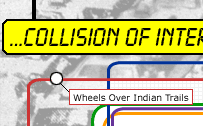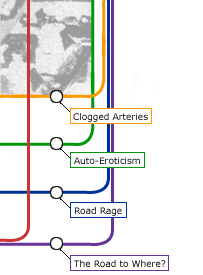



The Political Tool || Westway || The Stencilling Project || Carmageddon || Critical Mass || Critical Mass 10/31/00 || Fight for Oil
The Political Tool
by David Perry
Few articles ever used by man have created so great a revolution in social conditions as the bicycle.
-United States Census Report (1900)
Socailism can only come riding a bicycle.
-Jose Antonio Viera-Gallo, Assistant Secretary of Justice, Chile
Ideologies
The bicycle has become a political tool, due to its social, egalitarian nature, serving all alike.
Democratic, socialist, and communist cultures have all produced flourishing bicycle communities. Bicycle
uses vary by country and ideology, from the offical prohibitions on cycling in parts of North Korea, Saudi
Arabia, and the United Arab Emirates, to offical encouragement in the Netherlands. Democratic societies such
as the United States, which emphasize personal liberties and free markets, tend to develop innovative
approaches to bicycles for the benefit of recreation and business. Communist socioties such as China, which
emphasize community cooperation and government control, tend to develop practical approaches to bicycles in
more structured ways. Social-democratic societies such as the Netherlands, which blend public and
privitization, tend to develop innovative and practical approaches to bicycles in ways that reflect a special
understanding of the bicycle’s social nature.
Cuba is an example of a small country that is geo-politically situated between two powerful ideologies. As a small thorn at the foot of its capitalist neighbor, the U.S., Cuba embraed communism through the economic support of the U.S.S.R. This situation is reflected in Cuba’s vehicle traffic, where Soviet-built cars and trucks mix with old American vehicles leftover from before the U.S. trade embargo. In 1980, the country had about one motor vehicle per 5,000 people, and as in most developing nations progress was measured in horsepower, despite the high price of importing oil and motor vehicles on the economy and island’s environment.
In 1990, the breakup of the Soviet Union caused cut backs in oil shipments, and Cuba’s leader, Fidel Castro, addressed the energy crisis with a program called ÒSpecial Period in Time of Peace.Ó CubaÕs transportation system was restructured to emphasize bicycles for personal transport, based on the plans of Eugenio Balari, a government economist. By 1993, about a million practical bicycles were imported from China, and bike lanes were installed with traffic signs reading Atencion! Ciclos en la Via (ÓAttention! Cyclists in the roadÓ). Bikes were assembled at factory-schools, such as the Cuban-American Friendship Technology Institute, and cost about 125 pesos, over half the average monthly salary, with a 50 percent student-worker discount available. Balari describes the bicycle as Òa king’s gift... No one’s complained, everyone’s happy, everyone wants one: just look at the advantages. One, they save energy -- that ’s the main thing. Two, they’re practical, convenient. Three they help protect the environment, right? No pollution. Four, they’re less noisy; they contribute to the pacification and tranquility of the city. Five, the exercise and health benefits. Six, they improve you psyche by letting people see the city in a fuller and more beautiful way, not cooped up in a car. I see it as an advance, a progress. Everything it represents is positive." <1>
Cuba held a bicycle conference in 1993, where North America bike advocates saw a Havanna bus factory being
converted in to a bike factory. Future plans include the development of a domestic bicycle industry, with a
system for suppling parts and repairing bikes, as well as new bike traffic regulations and parking sites.<2>
Though some would like to see Cuba go motorized, its movement toward bikes supports the logical and
sustainable trend of promoting cycling for economical and environmental transport in developing countries.
Bikes Over Limos
The appeal for "bicycles over limousines" by ranking politicians is a popular way that bikes have been used as
a political symbol. Claiming a preference for bicycles -- an economical, clean, and egalitarian mode of
transport -- many a conservative or liberal, communist or democrat has declined a costly, pompous, chauffer-
driven limousine. Most famous was the proclamation made by Kim II Sung, the late Premier of Northern Korea,
who once said he preferred to use his bicycle instead of traveling in a western-style motorcade. Similarly,
in the U.S., a Connecticut state Governor, Ella Grasso, did not want to keep a limousine, and said she would
put the honorary car license plate, No.1, on her bicycle.
Limousines have evolved from decorative royal carriages into ominous black automobiles, symbolizing an amount of power and privilege that is clearly at odds with the idea of democratic public service. A few politicians make a point of driving common used cars, while others are proud to say they bicycle to work whenever they can. However, politicans are well-known for talking out of both sided of their mouths, saying different things to different people.
Once in a while an honest politican cames along, usually riding a bike. Bud Clark the Mayor of Portland, Oregon, who became known for the "Expose Yourself to Art" poster in which he exposed himself to a nude statue wearing only a raincoat, stood up for his jovial manners and habit of riding a StumpJumper mountain bike on the city business. Quoted in the International Herald Tribune, he said: "I'm not a funny man. I'm a serious man... I'm a conservative. I know you have to have money in the bank to pay your bills. People who think I'm eccentric misjudge me. Everyone in the world is different. That's what makes it wonderful. I've been riding a bicycle for a long time. <3>
Several U.S. Presidents have been cyclists, such as Franklin Delano Roosevelt, Dwight D. Eisenhower, who cycled at the advice of his physician Dr. Paul Dudley White, a well-known bike advocate; and Jimmy Carter, who rode regularly at the Camp David weekend retreat. Ronald Reagan was not a cyclist, but he appeared selling Schwinn bicycles and a bicycling paperboy is shown in one of his Morning in America TV commercials.
George Bush, the 41st President, was known to bicycle while serving as Ambassador to China From 1970-76. In a letter to John Dowlin of the Bicycle Network (June 4, 1975), Bush wrote: The more I think about the U.S. domestic transportation problems from this vantage point of halfway around the world, the more I see an increased role for the bicycle in American life. Obviuosly, some terrains make it more difficult, obviuosly some climates make it more difficult; but I am convinced after riding bikes an enormous amount here in China, that it is a sensible, economical, clean form of transportation and makes enormous good sense.
When George Bush became President he returned to Beijing in 1989. Trade was increased between the two countries and a diplomatic exchange of gifts occured between him and Premier Li Peng. George and Barbra Bush recieved a pair of cowboy boots with American and Chinese flags. Shortly thereafter, in Beiling’s Tiananmen Square, students on bicycles were massacred by the Chinese army during democratic uprisings.
In the 1992 Presidental campaign, former-candidate Eugene McCarthy said it was “like a sprint race with the riders going as slow as possible in early laps. President Clinton has made his inevitable political bike rides, in Massachusettes on a Merlin titanium mountain bike, with Congressmen Joseph Kennedy III, who is one of the highest ranking pro-bike politicans, and in California with his wife Hillary, on Specialized beach cruisers, with and without helmuts. In his Washington Post column, bike advocat Colman McCarthy urging vice president Al Gore to leave the limo at home,” saying he would be king of the road if he biked to work. Bikes are a subject not found in Gore’s environmental book Earth in the Balance.
Many people wonder when there will be a woman U.S. President. One of the first "lady candidates" was Belva Ann
Lockwood, a lawyer from Royalton, New York, who ran for president in the Equal Rights Party in 1884 and 1888.
When a photograph showed her campaigning on an English tricycle, she told the press: "There is a principle behind
that picture.A tricycle means independence for women, and it also means health." In 1884 she received 4,149 votes in
seven states, while Grover Cleavland won the election with 4.9 million votes. Lockwood helped pass the law
allowing women to practice before the U.S. Supreme Court.
Back to top